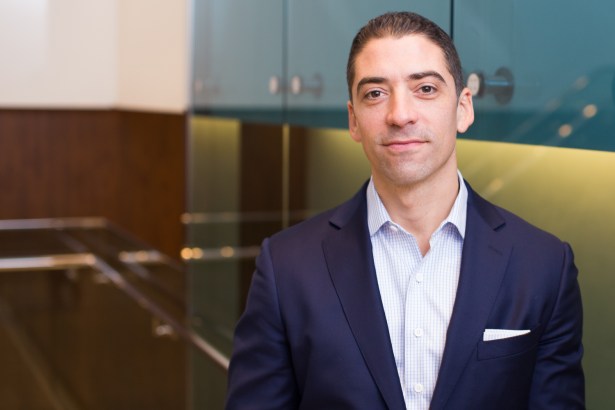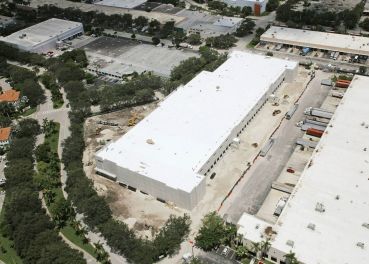CBRE’s Sacha Zarba: the Go-To Guy for NYC’s Hippest Tech Tenants
By Danielle Schlanger March 25, 2015 9:43 am
reprints

Sacha Zarba knows what tech tenants want.
“Typically, they prefer older building stock,” said the executive vice president at CBRE (CBRE). “They prefer pre-war, high ceilings, that brick and timber feel, exposed brick, lots of wood. They’re looking for buildings and neighborhoods where their workforce can feel at home. Access to amenities, nightlife, bars, restaurants. They [also] want to be close to where the leading technology firms are, so that they can [capitalize] on that creative vibe,” he said.
These TAMI (technology, advertising, media and information) tenants have become the darlings of the New York City real estate scene, beloved by brokers and courted by city officials. And Mr. Zarba has carved out a niche at CBRE as an expert in helping these ever-expanding firms find space in Midtown South, home of Silicon Alley and some of the most desirable neighborhoods for budding businesses, including Flatiron, Chelsea, Union Square and Soho. In 2010, he helped LinkedIn move from a temporary space into its first permanent New York City office at the Empire State Building. He worked with Mashable to help it find and move into its New York headquarters at 114 Fifth Avenue. And across the river in Dumbo, Mr. Zarba was responsible for Etsy, the e-commerce giant dedicated to artisan culture, expanding to 225,000 square feet from the 30,000 square feet it occupied in 2011 as part of a long-term strategy for growth.
“I can tell you that, having done this now for 16 years with eBay and probably 30 years overall, it’s rare that I find a real estate partner that is so much more than a transaction guy or gal. And Sacha falls into that category,” said Kevin J. Kearns, the director and head of global real estate at eBay Inc. “It’s not uncommon to know someone who knows their market and can provide guidance on negotiating basic terms of a deal. But where Sacha excels is that he knows his market, and he has established a very good relationship with all the major players on the landlord side.”
This, Mr. Kearns said, has proven to be tremendously beneficial. Mr. Zarba helped Mr. Kearns and eBay get special access to tour buildings and imparted his knowledge of space that may not be on the market at the moment, but could become available.
“He opens doors that a lot of other brokers wouldn’t be able to open,” said Mr. Kearns.
Mr. Zarba, who had considered a career in advertising while an undergrad at SUNY New Paltz, began his real estate career in 2000 working with these creative companies and felt himself being drawn to their energy.
“I liked the relaxed atmosphere,” he said. “The vibe was a bit younger, and it was something at that point that I could relate to. I got into working with creative firms from the start, which I think really paved the way [for my career].”
Gregory Tosko, the vice chairman of CBRE, has worked with Mr. Zarba on several assignments over the past 10 years. He said that Mr. Zarba’s hipness, combined with his knowledge of the market, make him a relatable broker and an invaluable resource for tech and creative tenants.
“[Sacha] is a unusual combination of hard work ethic and social adeptness who manages to be both current and experienced,” said Mr. Tosko. “This makes Sacha ideal for the burgeoning TAMI sector where many of its leaders want someone with whom they can identify (and who identifies with them) but can guide them with wisdom based on intelligence, street smarts and experience, especially as they grow to where real estate mistakes can be very costly.”
The aforementioned growth has become the norm for many of New York City’s creative companies, whose needs are often in flux and payrolls are often ever-growing. One of the earliest deals Mr. Zarba worked on was securing space for mcgarrybowen, an advertising company that was started in 2002 by John McGarry, the former president of marketing and communications behemoth Young & Rubicam. In late 2002, mcgarrybowen occupied 12,000 square feet at 936 Broadway. Today, the company, now owned by Dentsu, is in roughly 200,000 square feet in the RXR Realty-owned Starrett Lehigh Building at 601 West 26th Street between Eleventh and Twelfth Avenues.
LinkedIn has a similar story. When it opened its temporary New York City office in January 2007, it had roughly 20 employees in a temporary office suite at 41 East 11th Street. The company was there for roughly a year and a half before it decided to go out and secure its own office space. Today, LinkedIn’s office in the Empire State Building has 600 people spread across approximately 150,000 square feet, an expansion spearheaded by Mr. Zarba.
Midtown South wasn’t always the hotbed of real estate activity that it is today. Mr. Zarba noted that the area used to be a cost haven for companies looking to escape exorbitant rents in Midtown. But around 2009, technology firms really began coming into Midtown South and planting their flags in the neighborhood.
Some tech and creative firms began growing organically out of New York. Others with West Coast origins (Facebook and LinkedIn among them) began setting up shops in the Big Apple to complement their California headquarters. The talent pool of the region lured these companies east, along with access to a handful of industries (legal, media, advertising, financial) critical to their operations.
Part of this shift can also be attributed to companies putting their (increasingly younger) workforces first, at a time when millennials are living in Brooklyn or in Lower Manhattan.
“If you have a younger workforce and you are in media, finance, what have you, those people tend to [live] a bit further south,” Mr. Zarba said.
Therefore, the days of abundant deals in Midtown South are long gone. According to a CBRE report released this month, Midtown South recently surpassed its five-year monthly average by 43 percent. As of February 2015, asking rents in Midtown South were $66.70 per square foot. And many of the companies moving in or expanding are taking a sizable amount of square footage. When WebMD signed its lease at 395 Hudson Street last December, it committed to 148,000 square feet. In February, Facebook, adding to its growing New York real estate portfolio, added 80,000 square feet to its existing office at 770 Broadway. And in early March, TED Conferences signed a lease for 47,000 square feet at 330 Hudson Street. Any of these leases are enough to make landlords swoon.
Mr. Zarba says “34th Street is typically that dividing corridor” that separates the concentration of tech firms from the rest of the city. “You’re starting to see a lot of firms come further north, but that’s not because it’s necessarily where they would prefer to be, [but because it’s cost-effective],” he said.
He also stressed that not all Midtown South properties are the same; Soho buildings are known to have floor plates of 10 to 15,000 square feet (and oftentimes even smaller than that), whereas Hudson Square has a number of old printing buildings with floor plates triple that size.
“If you are a company and you are looking to scale, ideally you want one large floor plate … and neighborhoods like Soho are difficult to scale,” he said. “They’re great for startups but as you grow, you tend to look outside of Soho.”
Where then, do these companies go as they expand?
“Hudson Square is right next door,” said Mr. Zarba, with buildings that provide a particularly appealing opportunity for companies to grow horizontally rather than vertically.
Savvy landlords have started taking note of what these tech and creative companies need from their office space. These owners have made their buildings more energy efficient and have ensured their property’s technology is up to speed. Lobbies are undergoing makeovers. Companies like AT&T have been investing millions of dollars upgrading the distributed-antenna systems, cell service and fiber networks in buildings. And sustainability has taken on a newfound importance in the name of attracting companies used to greener Silicon Valley lifestyles.
“I don’t think we’re too far away from when composting in a building becomes more important than having a shiny lobby,” said Mr. Zarba.
These landlords also recognize that outdoor space is a highly coveted perk.
“Everyone wants outdoor space, but you can’t find it,” Mr. Zarba said. “The next best thing is when you go to a building, and the landlord dedicates a portion of, or the whole roof as an available amenity, that drives tremendous demand.”
As buildings re-brand to attract TAMI tenants and tech becomes a larger economic driver in New York, Mr. Zarba completely eschews the notion that Midtown South is merely fashionable and that it’s moment in the sun may come to an end.
“I think Midtown South is absolutely a viable and long-term place for New York. I don’t think it’s just trendy,” said Mr. Zarba. “More and more, you’re starting to see firms in the financial services sector, in the legal sector to some degree and certainly in media and publishing start to shift further south. It’s just generally a cooler place to do business.”


